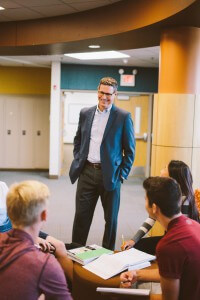January 12, 2017
 by Dr. Bill Hudson, Head of School
by Dr. Bill Hudson, Head of School
When I was a child, I spent countless hours playing with LEGOs. Mind you, it wasn’t the LEGOs popular now that come with instructions and a pre-defined outcome. In the days before Minecraft, you would have found me building cities out of blocks, Lincoln Logs, and even leaves in the fall. I liked to take things apart, to understand how they worked. I didn’t take time to read the directions (I still don’t) but rather jumped right into putting a new toy together.
Looking back, I can clearly see that I was, in today’s language, a maker. In a time (way) before 3-D printers, CNC routers, and laser cutters, I learned how to create, solve problems, and learn from failure. I learned how to look at a challenge from various perspectives and with persistence—attributes of a growth mindset, a concept coined by educational researcher, Carol Dweck. I didn’t have anyone to teach me woodworking or metallurgy and didn’t pursue a career in design or engineering, but still rely upon that mindset. How I approach not only my career, but life itself, flows from those formative experiences. Creativity, problem-solving, confidence, and critical thinking are skills and competencies that emerge from making and that I draw upon each day in my work.
I am honored to work with an Advisory Committee comprised of teachers, staff, parents, and students to create the MPA Makerspace. The overarching goal is to build a space where kids have the opportunity to make—a place where some tools, materials, and enough expertise can get them started. These places, called makerspaces, share some aspects of the shop class, home economics class, the art studio, and science labs. In effect, a makerspace is a physical mash-up of different places that allows makers and projects to integrate these different kinds of skills and develop a maker mindset.
Meeting monthly, the Committee worked collaboratively to develop a pedagogical statement to guide the program and facility. On Monday, the Committee energetically engaged in a process to set forth the core elements of the space. Together, participants set forth a vision that translates our MPA pedagogy into a reality. The next step is to meet with our architects and our construction company to share this vision with them so that they can create the physical space.
Jean Piaget, a pioneer in child development, once posed the question, “Are we forming children who are only capable of learning what is already known? Or should we try to develop creative and innovative minds, capable of discovery from the preschool age on, throughout life?” At MPA, we do both. Hands-on, experiential learning combined with deep content knowledge fueled by the inspiration to improve our world, is at the heart of the MPA Makerspace. The arts and humanities along with science, technology, and math balance so that students have the opportunity to both dream and do right and the context for both. Combining the technology and tools needed to create with the critical thinking necessary to understand how they are embedded in and can transform our world, is the MPA way. I am so excited for the Makerspace to become a reality and I hope you are as well!